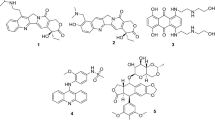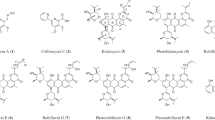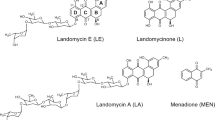Abstract
Anthracyclines such as doxorubicin are used extensively in the treatment of cancers. Anthraquinone-related angucyclines also exhibit antiproliferative properties and have been proposed to operate via similar mechanisms, including direct genome targeting. Here, we report the chemical synthesis of marmycin A and the study of its cellular activity. The aromatic core was constructed by means of a one-pot multistep reaction comprising a regioselective Diels–Alder cycloaddition, and the complex sugar backbone was introduced through a copper-catalysed Ullmann cross-coupling, followed by a challenging Friedel–Crafts cyclization. Remarkably, fluorescence microscopy revealed that marmycin A does not target the nucleus but instead accumulates in lysosomes, thereby promoting cell death independently of genome targeting. Furthermore, a synthetic dimer of marmycin A and the lysosome-targeting agent artesunate exhibited a synergistic activity against the invasive MDA-MB-231 cancer cell line. These findings shed light on the elusive pathways through which anthraquinone derivatives act in cells, pointing towards unanticipated biological and therapeutic applications.
This is a preview of subscription content, access via your institution
Access options
Subscribe to this journal
Receive 12 print issues and online access
$259.00 per year
only $21.58 per issue
Buy this article
- Purchase on Springer Link
- Instant access to full article PDF
Prices may be subject to local taxes which are calculated during checkout





Similar content being viewed by others
References
Kharel, M. K. et al. Angucyclines: biosynthesis, mode-of-action, new natural products, and synthesis. Nat. Prod. Rep. 29, 264–325 (2012).
Martin, G. D. A. et al. Marmycins A and B, cytotoxic pentacyclic C-glycosides from a marine sediment-derived actinomycete related to the genus Streptomyces. J. Nat. Prod. 70, 1406–1409 (2007).
Cottreau, K. M. et al. Diverse DNA-cleaving capacities of the jadomycins through precursor-directed biosynthesis. Org. Lett. 12, 1172–1175 (2010).
Sun, D., Hansen, M. & Hurley, L. Molecular basis for the DNA sequence specificity of the pluramycins. A novel mechanism involving groove interactions transmitted through the helix via intercalation to achieve sequence selectivity at the covalent bonding step. J. Am. Chem. Soc. 117, 2430–2440 (1995).
Hansen, M., Yun, S. & Hurley, L. Hedamycin intercalates the DNA helix and, through carbohydrate-mediated recognition in the minor groove, directs N7-alkylation of guanine in the major groove in a sequence-specific manner. Chem. Biol. 2, 229–240 (1995).
Singal, P. K. & Iliskovic, N. Doxorubicin-induced cardiomyopathy. N. Engl. J. Med. 339, 900–905 (1998).
Yang, F., Kemp, C. J. & Henikoff, S. Doxorubicin enhances nucleosome turnover around promoters. Curr. Biol. 23, 782–787 (2013).
Pang, B. et al. Drug-induced histone eviction from open chromatin contributes to the chemotherapeutic effects of doxorubicin. Nature Commun. 4, 1908 (2013).
Pigram, W. J., Fuller, W. & Hamilton, L. D. Stereochemistry of intercalation: interaction of daunomycin with DNA. Nature 235, 17–19 (1972).
Nitiss, J. L. Targeting DNA topoisomerase II in cancer chemotherapy. Nature Rev. Cancer 9, 338–350 (2009).
Korynevska, A. et al. Mechanisms underlying the anticancer activities of the angucycline landomycin E. Biochem. Pharmacol. 74, 1713–1726 (2007).
Müller, S., Kumari, S., Rodriguez, R. & Balasubramanian, S. Small-molecule-mediated G-quadruplex isolation from human cells. Nature Chem. 2, 1095–1098 (2010).
Koirala, D. et al. A single-molecule platform for investigation of interactions between G-quadruplexes and small-molecule ligands. Nature Chem. 3, 782–787 (2011).
Rodriguez, R. et al. Small-molecule-induced DNA damage identifies alternative DNA structures in human genes. Nature Chem. Biol. 8, 301–310 (2012).
Rodriguez, R. & Miller, K. M. Unravelling the genomic targets of small molecules using high-throughput sequencing. Nature Rev. Genet. 77, 5439–5444 (2012).
Yadav, J. S. et al. InBr3-catalyzed cyclization of glycals with aryl amines. Angew. Chem. Int. Ed. 42, 5198–5201 (2003).
Ding, C. et al. Synthesis study on marmycin A: preparation of the C3′-desmethyl analogues. J. Org. Chem. 74, 6111–6119 (2009).
Maugel, N. & Snider, B. B. Efficient synthesis of the tetracyclic aminoquinone moiety of marmycin A. Org. Lett. 11, 4926–4929 (2009).
Bourcet, E., Bröhmer, M. C., Nieger, M. & Bräse, S. Synthetic studies towards marmycins A and B: development of the vinylogous aldol–aza-Michael domino reaction. Org. Biomol. Chem. 9, 3136–3138 (2011).
Mendoza, A., Ishihara, Y. & Baran, P. S. Scalable enantioselective total synthesis of taxanes. Nature Chem. 4, 21–25 (2012).
Rodriguez, R., Chapelon, A.-S., Ollivier, C. & Santelli, M. Stereoselective synthesis of CD-ring precursors of vitamin D derivatives. Tetrahedron 65, 7001–7015 (2009).
Rodriguez, R., Adlington, R. M., Moses, J. E., Cowley, A. & Baldwin, J. E. A new and efficient method for o-quinone methide intermediate generation: application to the biomimetic synthesis of (±)-alboatrin. Org. Lett. 6, 3617–3619 (2004).
Rodriguez, R. et al. Total synthesis of cyercene A and the biomimetic synthesis of (±)-9,10-deoxytridachione and (±)-ocellapyrone A. Tetrahedron 63, 4500–4509 (2007).
Eade, S. J. et al. Biomimetic synthesis of pyrone-derived natural products: exploring chemical pathways from a unique polyketide precursor. J. Org. Chem. 73, 4830–4839 (2008).
Heinzman, S. W. & Grunwell, J. R. Regiospecific synthesis of bromojuglone derivatives. Tetrahedron Lett. 21, 4305–4308 (1980).
Carreño, M. C., Urbano, A. & Di Vitta, C. Enantioselective Diels–Alder approach to C-3-oxygenated angucyclinones from (SS)-2-(p-tolylsulfinyl)-1,4-naphthoquinone. Chem. Eur. J. 6, 906–913 (2000).
Brimacombe, J. S., Hanna, R., Saeed, M. S. & Tucker, L. C. N. Convenient syntheses of L-digitoxose, L-cymarose, and L-ristosamine. J. Chem. Soc. 2583–2587 (1982).
Greven, R., Jütten, P. & Scharf, H.-D. A new stereoselective route to branched-chain nitro and amino sugars: synthesis of both enantiomers of decilonitrose and avidinosamine. J. Org. Chem. 58, 3742–3747 (1993).
Baran, P. S., Maimone, T. J. & Richter, J. M. Total synthesis of marine natural products without using protecting groups. Nature 446, 404–408 (2007).
Klemer, A. & Rodemeyer, G. Simple synthesis of methyl 4,6-ortho-benzylidene-2-desoxy-alpha-D-erythro-hexopyranosid-3-ulose. Chem. Ber. 107, 2612–2614 (1974).
Wolfe, J. P., Wagaw, S., Marcoux, J.-F. & Buchwald, S. L. Rational development of practical catalysts for aromatic carbon–nitrogen bond formation. Acc. Chem. Res. 31, 805–818 (1998).
Sambiagio, C., Marsden, S. P., Blacker, A. J. & McGowan, P. C. Copper catalysed Ullmann type chemistry: from mechanistic aspects to modern development. Chem. Soc. Rev. 43, 3525–3550 (2014).
Larrieu, D., Britton, S., Demir, M., Rodriguez, R. & Jackson, S. P. Chemical inhibition of NAT10 corrects defects of laminopathic cells. Science 344, 527–532 (2014).
Enari, M. et al. A caspase-activated DNase that degrades DNA during apoptosis, and its inhibitor ICAD. Nature 391, 43–50 (1998).
Eskelinen, E.-L., Tanaka, Y. & Saftig, P. At the acidic edge: emerging functions for lysosomal membrane proteins. Trends Cell Biol. 13, 137–145 (2003).
Huynh, K. K. et al. LAMP proteins are required for fusion of lysosomes with phagosomes. EMBO J. 26, 313–324 (2007).
Klionsky, D. J. et al. Guidelines for the use and interpretation of assays for monitoring autophagy. Autophagy 8, 445–544 (2012).
Kågedal, K., Zhao, M., Svensson, I. & Brunk, U. T. Sphingosine-induced apoptosis is dependent on lysosomal proteases. Biochem. J. 359, 335–343 (2001).
Boya, P. & Kroemer, G. Lysosomal membrane permeabilization in cell death. Oncogene 27, 6434–6451 (2008).
Galluzzi, L., Bravo-San Pedro, J. M. & Kroemer, G. Organelle-specific initiation of cell death. Nature Cell Biol. 16, 728–736 (2014).
Li, H., Zhu, H., Xu, C.-J. & Yuan, J. Cleavage of BID by caspase 8 mediates the mitochondrial damage in the Fas pathway of apoptosis. Cell 94, 491–501 (1998).
Chipuk, J. E., Bouchier-Hayes, L. & Green, D. R. Mitochondrial outer membrane permeabilization during apoptosis: the innocent bystander scenario. Cell Death Differ. 13, 1396–1402 (2006).
Hamacher-Brady, A. et al. Artesunate activates mitochondrial apoptosis in breast cancer cells via iron-catalyzed lysosomal reactive oxygen species production. J. Biol. Chem. 286, 6587–6601 (2011).
Ziegler, S., Pries, V., Hedberg, C. & Waldmann, H. Target identification for small bioactive molecules: finding the needle in the haystack. Angew. Chem. Int. Ed. 52, 2744–2792 (2013).
Li, Y. et al. Amplification of LAPTM4B and YWHAZ contributes to chemotherapy resistance and recurrence of breast cancer. Nature Med. 16, 214–218 (2010).
Kreuzaler, P. & Watson, C. J. Killing a cancer: what are the alternatives? Nature Rev. Cancer 12, 411–424 (2012).
Shiraishi, N., Akiyama, S.-I., Kobayashi, M. & Kuwano, M. Lysosomotropic agents reverse multiple drug resistance in human cancer cells. Cancer Lett. 30, 251–259 (1986).
Zamora, J. M. & Beck, W. T. Chloroquine enhancement of anticancer drug cytotoxicity in multiple drug resistant human leukemic cells. Biochem. Pharmacol. 35, 4303–4310 (1986).
Vezmar, M. & Georges, E. Reversal of MRP-mediated doxorubicin resistance with quinoline-based drugs. Biochem. Pharmacol. 59, 1245–1252 (2000).
Savarino, A., Lucia, M. B., Giordano, F. & Cauda, R. Risks and benefits of chloroquine use in anticancer strategies. Lancet Oncol. 7, 792–793 (2006).
Acknowledgements
The authors thank the CNRS for funding, and the Imagif Cell Biology Unit, J.-F. Gallard and F. Blanchard for assistance with cell imaging, NMR spectroscopy and X-ray crystallography, respectively. R.R. thanks J.A. Yeoman, S. Müller, J.E. Moses, S.L. Buchwald, L. Johannes, M. Mehrpour and members of R.R.’s laboratory for discussions and proofreading of this manuscript. Research in R.R.’s laboratory is supported by the European Research Council (grant no. 647973), the Fondation pour la Recherche Médicale (grant no. AJE20141031486), the Emergence Ville de Paris Program and the Ligue Nationale Contre le Cancer.
Author information
Authors and Affiliations
Contributions
R.R., with contributions from T.C., G.M. and M.M., conceived and designed the experiments. T.C., with assistance from F.G., synthesized the marmycins and artesumycin. T.T.M. with contribution from T.C. performed proliferation assays, fluorescence-activated cell sorting, western blotting and cellular imaging. R.R., G.M. and M.M. supervised the research. All the authors analysed the data. R.R. wrote the manuscript. All the authors commented on the manuscript. T.T.M. and F.G. contributed equally to this work.
Corresponding author
Ethics declarations
Competing interests
The authors declare no competing financial interests.
Supplementary information
Supplementary information
Supplementary information (PDF 3569 kb)
Supplementary information
Crystallographic data for compound 1. (CIF 443 kb)
Rights and permissions
About this article
Cite this article
Cañeque, T., Gomes, F., Mai, T. et al. Synthesis of marmycin A and investigation into its cellular activity. Nature Chem 7, 744–751 (2015). https://doi.org/10.1038/nchem.2302
Received:
Accepted:
Published:
Issue Date:
DOI: https://doi.org/10.1038/nchem.2302
This article is cited by
-
Landomycins as glutathione-depleting agents and natural fluorescent probes for cellular Michael adduct-dependent quinone metabolism
Communications Chemistry (2021)
-
Visualizing biologically active small molecules in cells using click chemistry
Nature Reviews Chemistry (2018)
-
Salinomycin kills cancer stem cells by sequestering iron in lysosomes
Nature Chemistry (2017)



